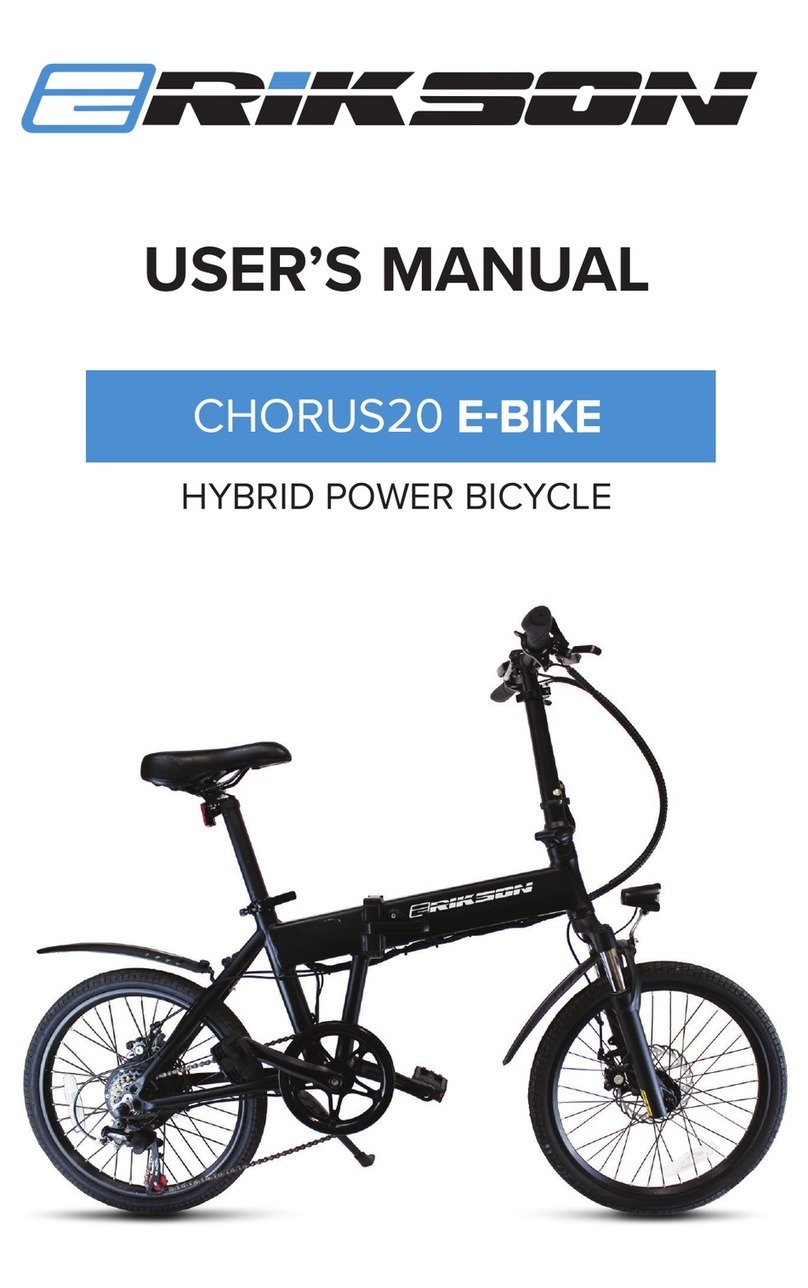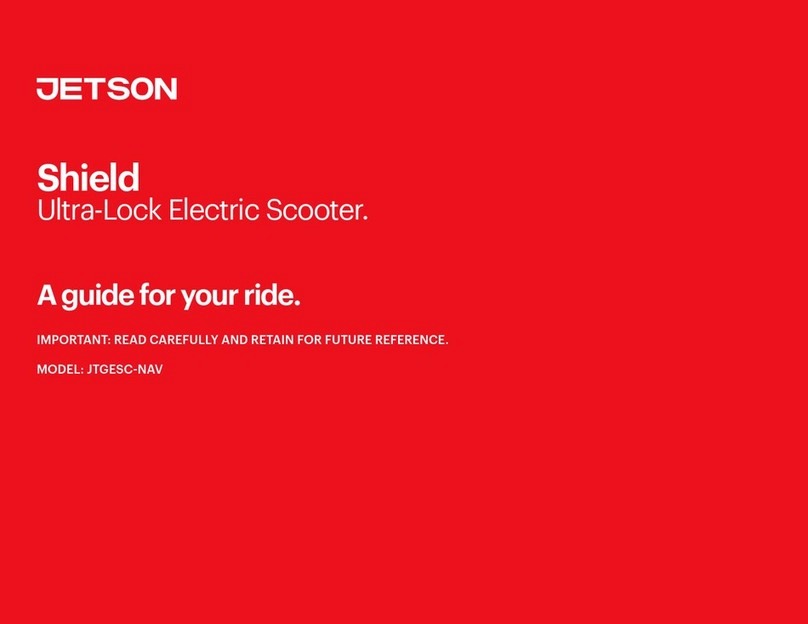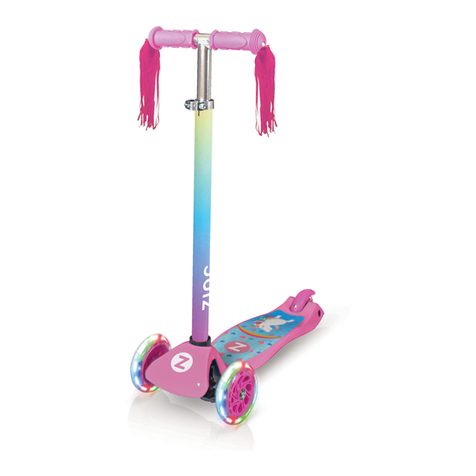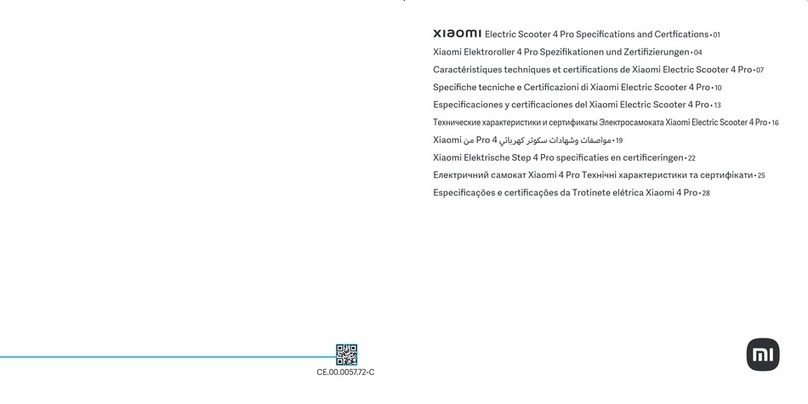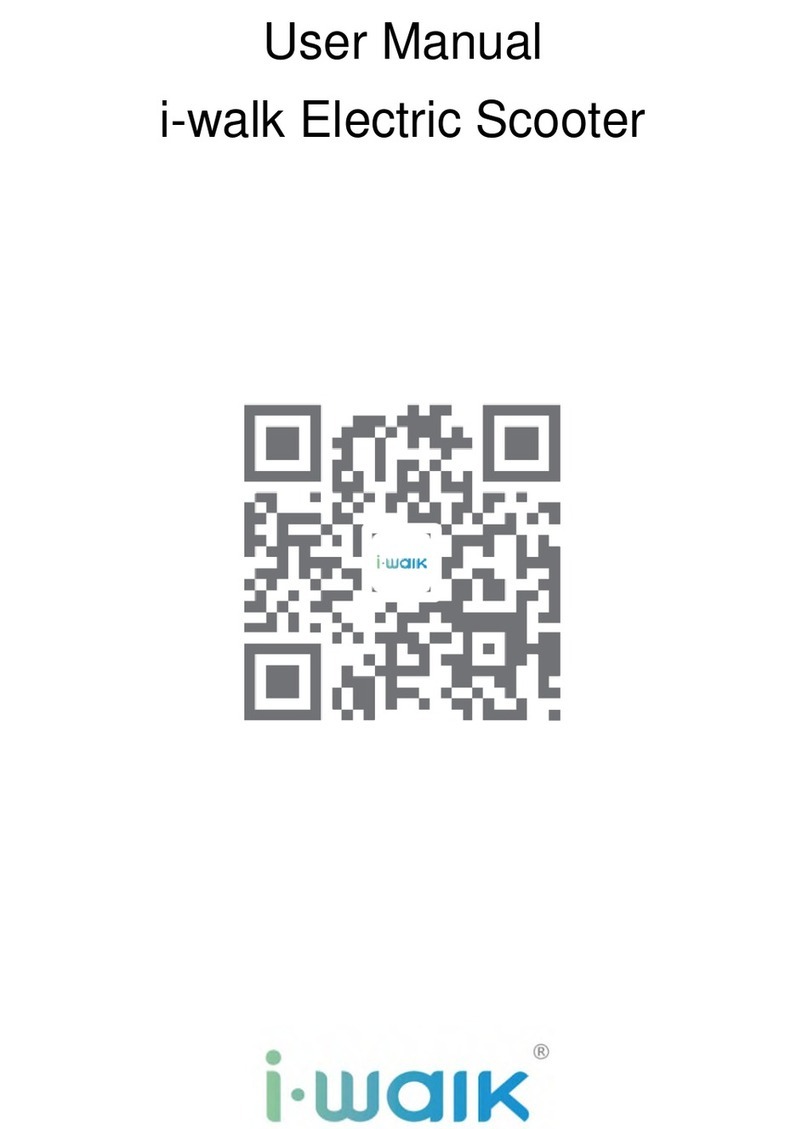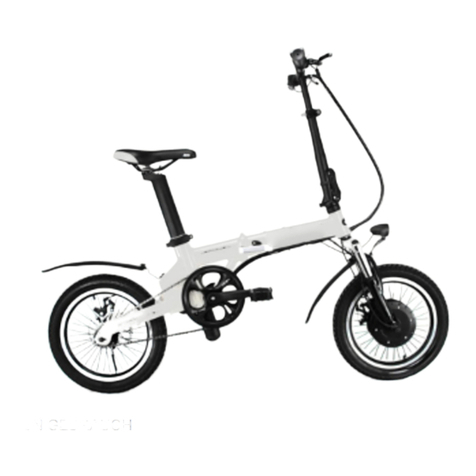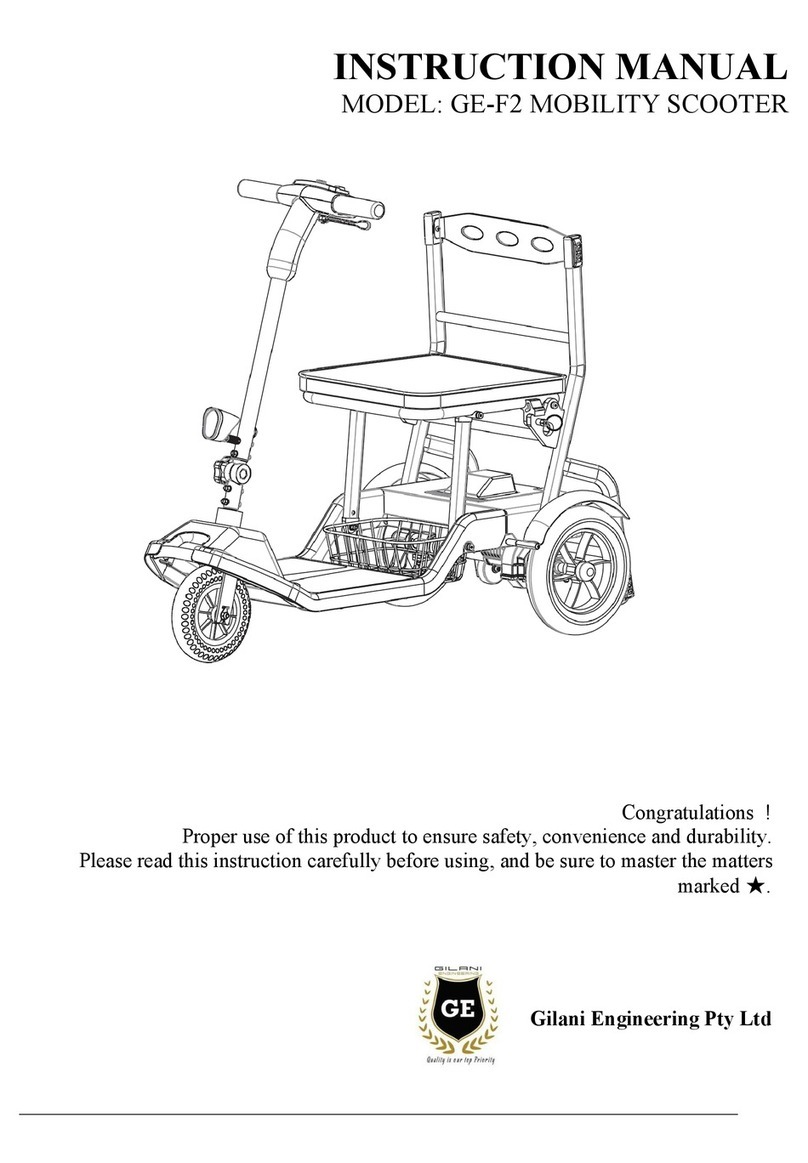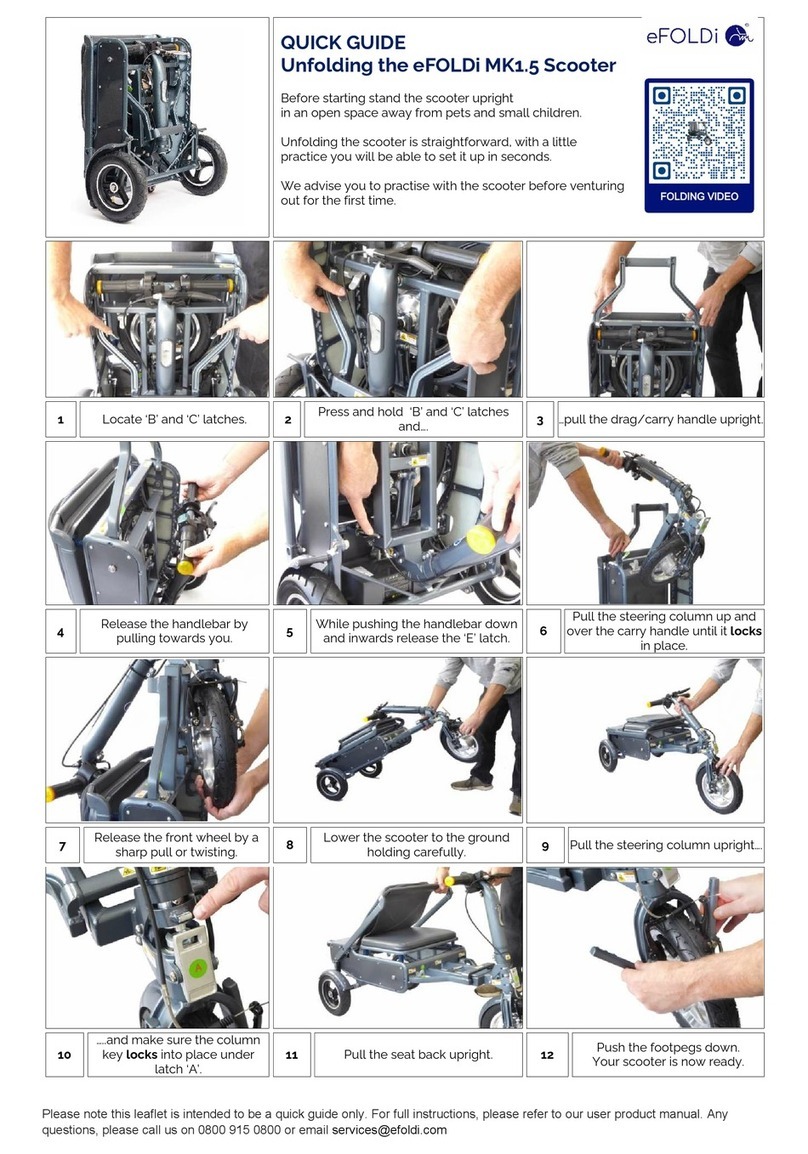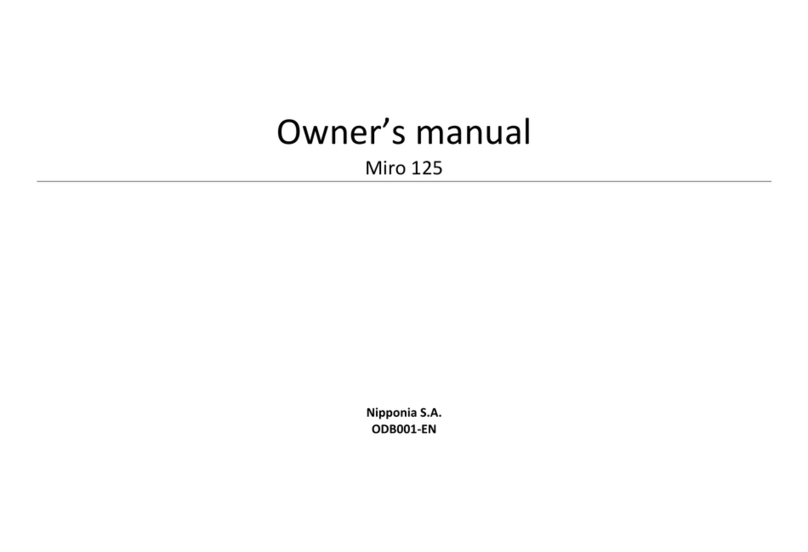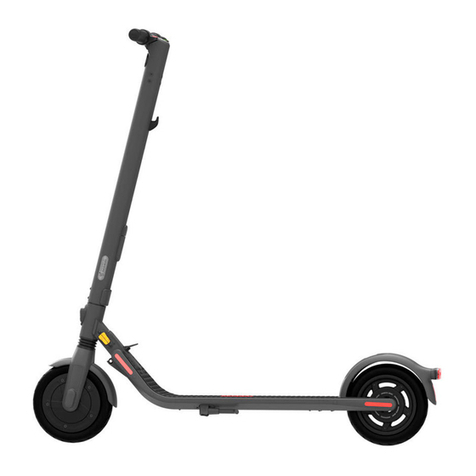ERIKSON CHORUS20 User manual

USER’S MANUAL
CHORUS20 E-BIKE
Hybrid Power Bicycle

2
IMPORTANT SAFETY INFORMATION...................................4
GETTING TO KNOW YOUR E-BIKE
• Contents of the box............................................................6
HOW TO FOLD AND USE
• How to fold.........................................................................6
• How to use .........................................................................6
OPERATION & ADJUSTMENT
• Introduction to the hybrid-powered system .....................7
• Battery and charging.........................................................7
• Battery maintenance .........................................................8
• Cycling computer operations ............................................9
• Saddle position ................................................................ 11
• Brake system................................................................... 12
• Derailleur.........................................................................13
USE AND MAINTENANCE
• Intended use ....................................................................15
• Before the ride.................................................................15
• Before each ride .............................................................. 16
• Regular cleaning .............................................................16
• Regular checks................................................................17
TECHNICAL INFORMATION .................................................18
FCC | CE...................................................................................18
TABLE OF CONTENTS

3
ABOUT ERIKSON
Designed for performance, comfort and convenience,
the Erikson brand offers a full assortment of battery-
powered bikes and accessories. Passionate about
transforming the personal commuter experience,
Erikson is pushing the boundaries of conventional
transportation and has developed an exciting range
of products aimed to cater to new and experienced
riders alike. Erikson bikes are a sustainable alternative
to fuel-powered transit, and revolutionizing everyday
transportation and recreational riding.
CONTACT
If you have any questions related to this Erikson product,
including proper operation, maintenance, warranty
information, safety concerns, or if you want to give
us your feedback, we are here to help you. We can be
reached at the “Contact Us” page on EriksonBikes.com.
We are happy to assist you.

4
IMPORTANT SAFETY INFORMATION
• Do not operate this e-Bike without carefully reading the manual and
understanding how to operate the e-Bike.
• Wear your helmet, gloves and other protective gear before riding
to protect yourself from injury in case of an accident. We recommend
wearing bright or reflective clothes when riding at night.
• Observe rules and regulations when using this e-Bike. Passengers
should not be carried. When riding in rainy, snowy or slippery
conditions reduce your speed and increase the distance between
yourself and other vehicles.
• Your insurance policies may not provide coverage for accidents
involving the use of this e-Bike; to determine if coverage is provided
you should contact your insurance agent.
• Charge the battery in a dry place and ensure there is ventilation.
Neither the battery nor the charger should be covered during the
charging process. A lot of heat can be created during the charging
process and this has to be able to escape. Otherwise this could
lead to a danger of overheating or a possible hazard. We recommend
charging under supervision or with the user present. Only use an
Erikson charger to charge the battery.
• If planning to store the battery for a long time without using it, make
sure to charge it before storing. The battery is best preserved in
a cool and dry environment. It also needs to be charged once a month
if planning to store for several months.
• Lock then remove the key before riding. Otherwise, you may injure
yourself on the protruding key, lose or damage the key, or the battery
could become loose and fall out. This could result in accidents and
injury.
• The e-Bike should not be left out in the rain for a long time or
submerged because if water enters into the controller and motor
wheel, it may cause short circuit and damage the electrical
components.
• Keep appropriate air pressure inside the tires, so as to avoid
increasing friction when riding, as low air pressure may easily wear
the tires and deform the rim.
• When riding with high speed or downhill, use the rear brake to avoid
the center of gravity from moving ahead, as using the front break may
result in a shift in the center of gravity and may be dangerous.
• Do not alter any components on the e-Bike. Any changes to
the e-Bike not approved by Erikson will nullify the warranty
on the manufacturer’s side and may result to damage or injury.

5
GETTING TO KNOW YOUR E-BIKE
18
17
11
10
12
7
1
2
3
5
4
6
15
9
8
16
14 13
1. Handle bar
2. Folding stem
3. Headlight
4. Suspension front fork
5. Front wheel set
6. Disk brake
7. Cycling computer
8. Folding lock
9. Seat (saddle)
10. Mudgaurd
11. Rear wheel set
12. Inside battery
13. Cranks
14. Chainring
15. Seat clamp
16. Chain
17. Motor
18. Derailleur

6
CONTENTS OF THE BOX
Chorus20 Electric Bicycle 1 Piece
Battery with keys 1 Set
Charger 1 Piece
Pedal 1 Pair
Handle bar 1 Set
Front wheelset 1 Set
Saddle with seat post 1 Set
This user manual 1 Piece
HOW TO FOLD AND USE
HOW TO FOLD
1. Open the quick-release clamp on the seat post and push the seat
all the way down. Move the pedals to 3/9 o’clock position. Push
inward both pedals .
2. Unlock and release the handlebar stem quick-release clamp and
fold the stem.
3. Unlock and release the folding clamp, fold the e-Bike until both
wheels are parallel.
HOW TO USE
1. PAS mode: press on cycling computer for 2 seconds, press
to choose power assist level, tread the pedal, then start.
2. None-Assistant mode: press on cycling computer for 2 seconds,
press to 0 class.
1 2 3

7
OPERATION AND ADJUSTMENT
INTRODUCTION TO THE HYBRID-POWERED SYSTEM
The Hybrid Power system consists of the following components:
• Smart Sensor – Sensing your pedaling rate and velocity.
• Smart Controller – Real time calculating and coordinating
optimized power output.
• Battery Management System – Providing electric power to the
system while balancing the power consumption and protecting the
battery cells.
• BLDC Motor – Provide the power assist.
• Cycling computer – Control and display terminal.
As soon as you start pedaling, the system will sense your cadence
(pedaling rate) and traveling speed and control the motor in real-
time to provide the “just-right” power assist that matches your riding
conditions, making your riding much easier and more comfortable .
With the hybrid system you have the option to avoid a sweaty commute,
or be slowed by an injury, headwinds or hills, and just enjoy riding.
BATTERY AND CHARGING
The battery should be charged before it is used for the first time. Please
only use the charger designated by Erikson for charging; otherwise it
might damage the battery, and may even lead to fire and other hazard.
Warranty will be voided if a charger other than the one designated by
Erikson is used.
CONTROLLER BMS
SMART CENSOR
SMART CYCLING
COMPUTER
BRUSHLESS MOTOR

8
1. Check carefully whether the rated input voltage of the charger is
consistent with the voltage of the power grid.
2. Connect first the output plug of the charger with the charging
jack of the battery properly, and then connect the input plug of
the charger to the AC power supply.
3. Fully charge of an “empty” battery takes 3-4 hours, when the
charge indicator light on the charger turns from red to green, the
battery has been fully charged.
4. After charging, first pull out the AC power plug, and then pull out
the plug connected with the battery.
SAFETY CONCERNS
1. The battery should be charged in a open environment, staying
away from high temperature, high humidity and fire, because the
battery and the charger are electronic products, high
temperature and humidity will corrode electronic components,
resulting in some harmful gases and soot, and even a possible
explosion.
2. The charging time should not be too long. An excessive charging
time will lead to shortened life expectancy of the battery.
BATTERY MAINTENANCE
1. You can achieve the best possible performance and lifespan of
your battery by charging on a regular basis and using it within the
recommended temperature range. The battery has almost no
memory effect thanks to the Li-ion technology.
2. Leaving a fully discharged battery for a long time will lead to
permanent loss of function. Please recharge an empty battery as
soon as you have a chance to. If storing the battery for an
extended period, we recommend to recharge at least up to ¾
(4 LEDs) at least every 30 days to avoid damage to the battery. A
dead battery due to neglect is not a warranty claim.
4. Every battery with Li-ion technology is subject to an unstoppable
chemical aging process. Provided the bicycle has been used
properly, remaining capacity of 85% after 500 charging cycles.
5. Please follow municipal regulations as to how to discard the
battery appropriately, so as to avoid environmental pollution.
6. Recommended temperature ranges:
a. Charging/Discharging: 0-45˚C, 32-113˚F
b. Storage: <35˚C / 95˚F

9
CYCLING COMPUTER OPERATIONS
Function and Display
1 UP
11
KM/H Speed (km/h)
2 POWER MPH Speed (mile/h)
3 DOWN MXS Max Speed Per Trip
4ASSIST Assist Level AVS Average Speed
5 Remaining Battery Capacity
12
Km Range (km)
6CRUISE CRUISE Mil Range (mile)
7PAS Power Assist DST Range Per Trip
8
TM Time Per Trip ODO Total Range
TTM Total Trip Time VOL Battery Voltage
9THROTTLE Throttle ON 13 Braking
10 Pushing Mode 14 Light ON

10
POWER ON / OFF
Press for 3 seconds, power will be on.
When power is on, press for 3 seconds, power will be off.
When power is on, if no action for 10 minutes, then cycling computer will
be shut off automatically.
CYCLING COMPUTER OPERATION GUIDE
Open the back-light of cycling computer and open bicycle front light (for
riding at night).
Switch power assist level
Pushing Mode
Press , power ON this interface will show.
Long press , cycling computer back-light and
bicycle front light will be turned on.
Long press again, cycling computer back-light
and bicycle front light will be turned off.
Press or , switch 0 to 5 level.
Level 1 is the lowest, level 5 is the highest.
Level 0 is no power assist.
While pushing this bike on the way, keep
pressing to turn on the pushing mode, this
bike will run at a speed of 6km/h to save your
strength. Release to quit pushing mode.

11
SADDLE POSITION
A properly adjusted saddle can minimize discomfort on the-Bike and
make your pedaling more efficient. Take some time to get the correct
saddle position as it will improve your overall riding experience. Saddles
can be adjusted in three ways: saddle height, forward/backward
position and tilt. To adjust you simply loosen the bolt/clamp, adjust and
re-tighten.
SADDLE HEIGHT
The saddle height controls the leverage for your pedaling. Too low
and it puts stress on your knees, too high and you may rub the saddle
excessively. There are a number of ways to get the right saddle height.
A good way of doing it is to sit on the-Bike with both feet on the pedals
– get a friend to help, use a trainer or lean against a wall. Place your
pedals in the 6 o’clock and 12 o’clock position. Your bottom leg should be
fully extended when the heel is placed on the lower pedal. If it’s bent you
need to raise the saddle. If you have to rock your hips to reach or simply
can’t reach, then lower the saddle. You can also tell if the saddle is too
high if you find you are sitting on the narrow front part of the saddle. If
you want to do it more scientifically, use this web-based tool:
http://www.ebicycles.com/bicycle-tools/saddle-height
When pedaling, PAS icon is on.
When speed is reaching/above 7km/h, long
press to enter into cruise mode.
Then cruise icon will be showed on display.
Brake or press any button to quit Cruise mode
PAS Mode
Cruise Mode

12
SAFETY CONCERNS
The seat post has a MAX marked line (that is, the safety line), this is the
MAX height that you can raise the saddle. In any cases of adjustment,
the MAX marked line should always below the seat post clamp. Serious
injury may be caused to the rider if the saddle height is raised beyond
the MAX line.
SADDLE FORWARD/BACKWARD POSITION
The forward/backward position of the saddle will determine how your
body is balanced which will also dictate how comfortable and effective
you are on the e-Bike. One way of positioning the saddle is to put it 2 to
2.5 inches behind the centerline of the bottom bracket axle or spindle.
SADDLE TILT
The saddle tilt is also important. If the nose is tilted down too much it
will slide you onto the narrower part of the saddle, movement which
then tends to be countered in the hands, putting strain on your arms
and shoulders. If it’s tilted up too much you’ll feel it in your genital area.
The general rule is to set the saddle parallel to the ground however
some women prefer a slight down-tilt (particularly if they use saddles
designed for men) and men a slight up tilt, but this should be very small.
Whatever position you want to try, test it out for a week or so, change it
again slightly and try it again until it’s just right.
BRAKE SYSTEM
The braking system is an accessory necessary for each bike and is
key to riding safety. The braking system includes brake levers, brake
assemblies and a brake cable.
Left Brake Lever: Front Brake
Right Brake Lever: Rear Brake

13
DERAILLEUR
Name of Parts
Gear Shifting Operation
Be sure to keep turning the crank during the lever operation.
(A) When you want to make pedaling easier. Push the lever in the
direction of the arrow to shift to each of the gears.
Rear side
Thumb shifter Plus
SL-TX
Bottom Lever
Crank

14
Rear side (Right)
Thumb shifter Plus
SL-TX (A)
Chain position
4 3
(A)
Rear side (Right)
Thumb shifter Plus
SL-TX
Chain position
(B)
34
smaller sprocket → larger sprocket
smaller sprocket → larger sprocket
Button (push)
(B) When you want to make pedaling harder. Push the lever or
button in the direction of the arrow to shift to each of the gears.

15
INTENDED USE
This e-Bike is intended for transporting one person at a time. Fit your
bicycle with suitable equipment if you would like to transport cargo.
Ensure that you do not exceed the maximum permissible load (rider +
luggage) of 330 lb (150 kg).
The manufacturer and dealer do not assume any liability for activities
above and beyond the intended use. This particularly applies for not
adhering to safety advice and damage resulting from this, for instance:
off-road use, carrying excess weight or making improper repairs to
defects. The-Bike is not generally designed to withstand extreme
stress, such as riding down large steps or over jumps.
BEFORE THE RIDE
1) Please fully charge the battery before the first use.
2) Please ensure that your e-Bike is ready for use and is adjusted to
your body, including:
a) Setting the position and fixture of the seat and handlebar
b) Checking the assembly and settings of the brakes
c) Securing the wheels into the frame and fork
d) Checking the tire pressure
3) Ensure that you know which lever operates which brake. Operate
and ride your bicycle in a quiet and safe place.
4) Ensure that the wheels are securely fastened in the frame and
fork. Check that the wheels and thru axles as well as all important
nuts and bolts are secure.
5) Push the wheels forward with the brakes pulled. The back brake
should completely prevent the back wheel from moving, while the
front brake should lift the back wheel off the ground with its
braking effect. The bicycle’s steering should not rattle under
braking or exhibit any play (right/left).
6) The effectiveness of brakes can be different in wet conditions or
on slippery surfaces. Please take into account the possibility of
longer braking distances and slippery road surfaces when riding.
7) Check the air pressure in the tires. Please adhere to the required
minimum and maximum pressure. As a general rule of thumb,
e.g. on a ride, you can check the tire pressure as follows: If you
place your thumb on a pumped up tire, you should not be able to
significantly change its shape by applying pressure.
USE AND MAINTENANCE

16
8) Check the tires and rims. Scan them for any damage, cracks or
deformations, as well as embedded particles, e.g. shards of glass
or sharp stones.
9) If you should find any cuts, rips or holes in the tires, please refrain
from riding. First have your bicycle checked over by qualified
bicycle mechanics or contact Erikson service team.
BEFORE EACH RIDE
Before each ride, please check that:
1) The brakes are working safely and are properly secured.
2) The tires are free of foreign objects and damage, and the wheels
run true.
3) The tires have sufficient pressure and tread depth.
4) All bolts and nuts are tight.
5) Check that all quick releases are still correctly secured.
6) The frame and fork are not damaged.
7) The handlebar and stem are correctly and securely fastened as
well as set up in the correct position.
8) The seat post and seat are secure and in the correct position. Try
turning the seat or tipping it upwards or downwards. It should not
move.
REGULAR CLEANING
1) Avoid using water spray to clean the-Bike as the electrical and
electronic systems may get wet, resulting in malfunction of the
e-Bike or personal injury.
3) Delicately wipe any dirty painted or plastic parts with a soft, damp
cloth and a neutral cleaning solution. Carefully dry the parts with
a soft, dry cloth.
5) DO NOT grease or use a greasy cloth to wipe down the electrical
connectors, brake pads, wheels, tires or plastic parts.

17
REGULAR CHECKS (EVERY 1-2 MONTHS)
1) Check that the handlebar attachment and saddle post are correctly
inserted and tightened.
2) Check that the wheel hub mounting bolts and quick-release are
correctly tightened.
3) Check that the wheel rims are not cracked and that no spokes are
loose or broken.
4) Check that the tires have sufficient thread depth and not punctured.
5) Check that the tires are correctly inflated.
6) Check that the batteries are sufficiently charged.
7) Check that the front and rear brakes brake effectively.
8) Check that the cables are sufficiently greased, and that the brake
pads are in good condition.
9) Check that frame welds are in good condition and are free from
corrosion or oxidation.

18
This equipment has been tested and found to comply with the limits for a Class
B digital device, pursuant to Part 15 of the FCC rules. These limits are designed
to provide reasonable protection against harmful interference in a residential
installation. This equipment generates, uses and can radiate radio frequency
energy and, if not installed and used in accordance with the instructions, may cause
harmful interference to radio communications. However, there is no guarantee
that the interference will not occur in a particular installation. If this equipment
does cause harmful interference to radio or television reception, which can be
determined by turning the equipment off and of, the user is encouraged to try and
correct the interference by one or more of the following measures: Reorient or
relocate the receiving antenna; increase the separation between the equipment and
receiver; connect the equipment into an outlet on a circuit different from that of the
receiver; consult the dealer or an experienced radio/TV technician for help.
TECHNICAL INFORMATION
Frame Light weight Aluminum Alloy
Size Unfold: 1460 x 560 x 1100 mm
Weight 41Lb (18 Kg) with battery
Max Load 330 lb (150 Kg)
Power Assist Mode 5 Level Pedelec
Motor 36V 250W DC Brushless Motor
Battery 36V 7.8Ah Li-ion Battery. LG or Samsung Cell
Max Assisted Speed 32km/h - 20 Mph
Brakes Disc Brakes

19

SERIAL NUMBER
www.EriksonBikes.com
Other manuals for CHORUS20
1
Table of contents
Other ERIKSON Scooter manuals
